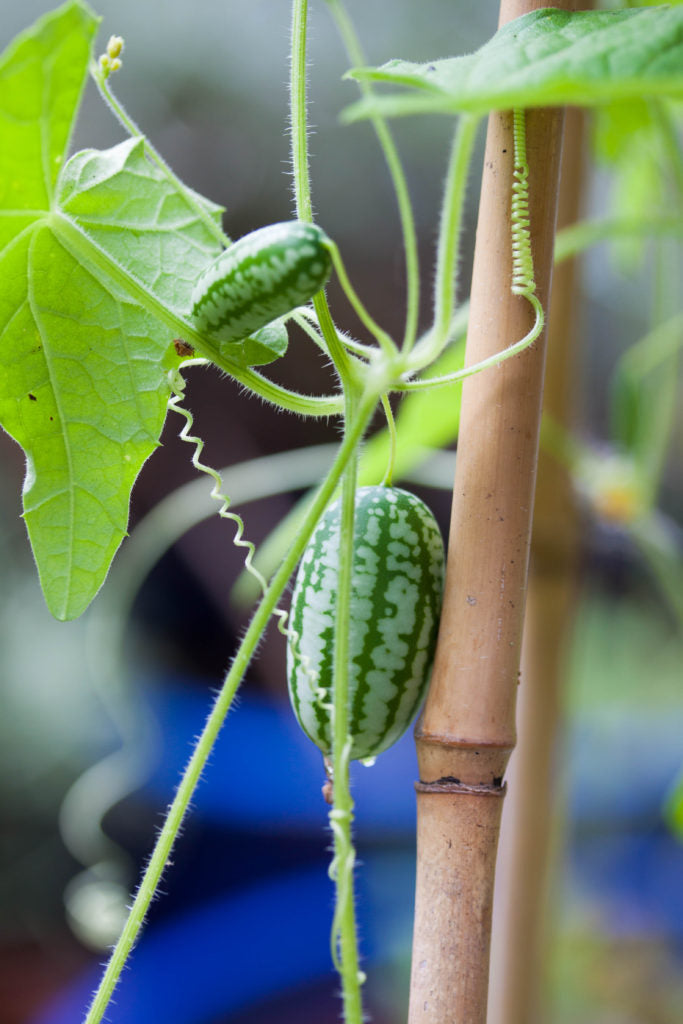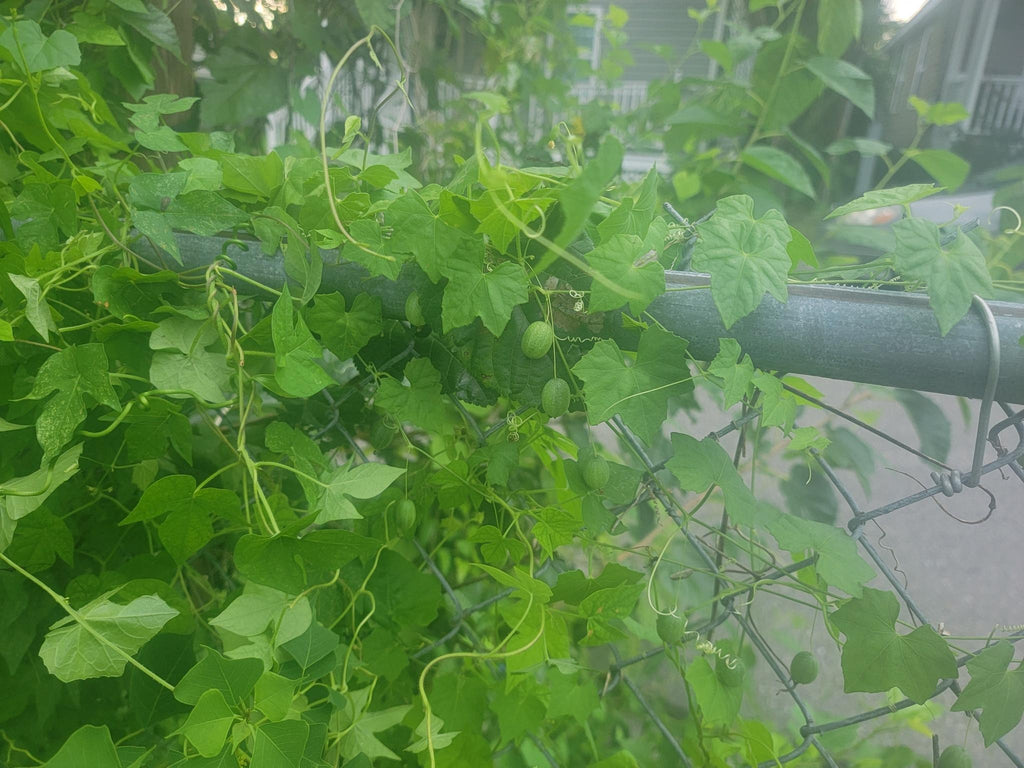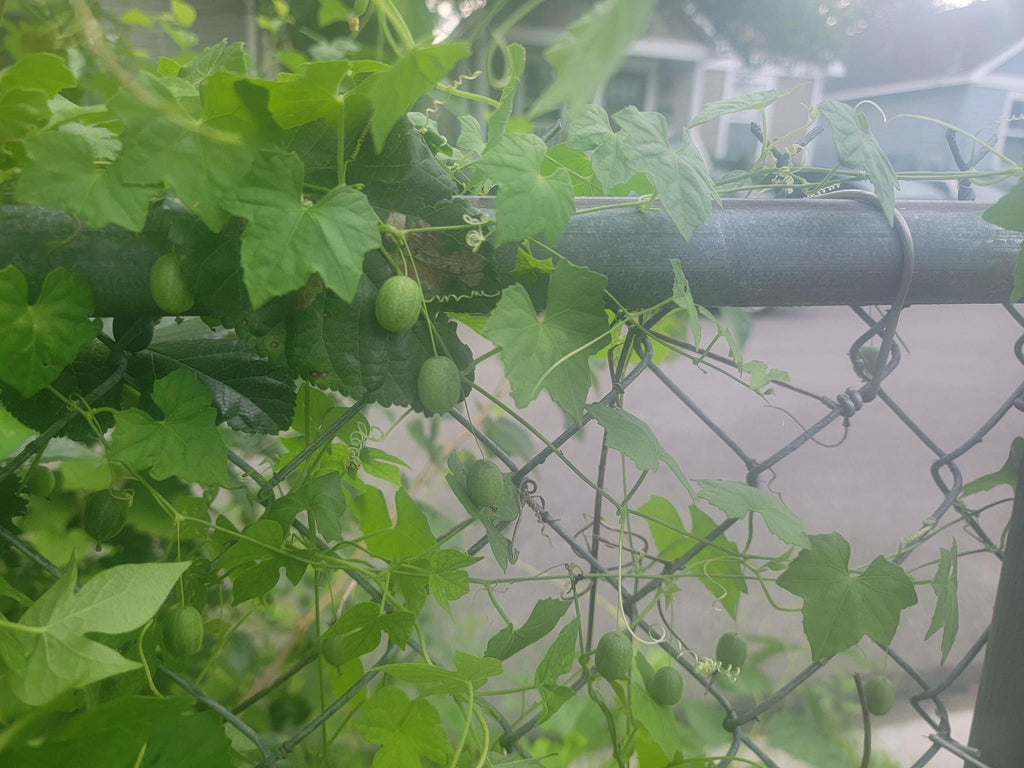
Every now and then a plant comes along that surprises us a little bit, and this blog is focused on one of them. Cucamelon is quite literally popping up all over the place, often as an unexpected guests in many gardens. We first found it growing feral in our Gardzen Test Gardens, and soon after we were seeing seeds for sale via heirloom seed dealers and plants for sale in smaller nurseries. Cucamelon is an intriguing and surprisingly useful garden plant, so let’s dig in and learn a bit more about it!
What is Cucamelon?
Cucamelon is a plant with many names. Scientifically it’s known as Melothria scabra, but it also goes by a bewildering number of monikers including Mexican miniature watermelon, Mexican sour cucumber, Mexican sour gherkin, mouse melon, pepquino, or sandita. The popular name varies from region to region—and there are a lot of regions! This plant has a native range that spans Mexico, Central America, and the northern part of South America. Like many species, it has expanded that range due to human action, and can now be found growing wild across the more temperate parts of North America.
Cucamelon is a member of the Curcurbitacea family, which includes both Old World plants like cucumber, watermelon, and gourds as well as New World plants like squashes. The best way to describe cucamelon is as a “miniature cucumber”. While this isn’t strictly accurate in a botanical sense, it does convey the plant’s appearance fairly well. Everything about it—the leaves, the flowers, the fruit—looks a bit like a mini-cucumber. It grows a bit like a cucumber, with long vines and fruit hanging off of tiny stems. The fruit are about the size of a small grape, and they taste—you guessed it—a lot like cucumber! A perennial in its native range, it grows more like an annual in the US and parts of Canada. We first encountered it growing feral—the tiny fruits are much loved by birds, who spread the seeds far and wide!

How to Grow Cucamelon
Cucamelon is fairly easy to grow, and easily adaptable to either in-ground growing or containers. The vines can get quite long—although not as long as full-sized cucumbers—so make sure you give it a trellis, fence, or other support to wind its way onto. These plants like sunny spaces with rich, well-drained soil. Like many members of the Curcurbitacea family, they feed fairly heavily so regular applications of fertilizer or compost are a must, along with good, deep watering. The plants are relatively heat- and drought-tolerant, but fruit production suffers under these conditions.

When you have your planting site or container prepared with good rich soil, good drainage, and a support for the vines, it’s time to plant! Cucamelons like warm soil and warm temperatures, so definitely plant well after your last frost date has passed. The good news is that these heat-loving plants can be planted throughout the season, although seedlings may benefit from extra water and a bit of shade if started in mid-summer. As with cucumbers, mulching the surface of the soil can help conserve water and nutrients, so don’t neglect it! Plant your cucamelons roughly 1 inch/2.5cm deep, and space your plants approximately 18 inches/45cm apart. Good air circulation helps prevent powdery mildew—one of the few diseases to which cucamelon is susceptible.

Companion planting for cucamelon isn’t necessary, but it can help. Like its cucumber, melon, and squash cousins, cucamelon requires pollination to produce fruits, so planting bee-friendly flowers nearby can help. And yes—you can hand-pollinate cucamelon! Just use a very small paintbrush and be very careful with the tiny flowers.
Using Cucamelon Fruit
While cucamelon can make for a lovely ornamental with its cute little leaves and lovely yellow flowers, the fruits are edible, delicious, and quite refreshing. Generally speaking, we just eat them fresh—often munching on them directly off the vine while working in the garden. They will keep in the fridge for up to two weeks, and it’s best to store them in the crisper or vegetable drawer.
Cucamelon fruit are ripe when they’re fully green with dark green stripes. Overripe fruit turn dark purple or black and while those are safe to eat they’re less tasty and best used for seeds or left for the birds. Cucamelon can be preserved via pickling, just like true cucumbers.

Give Cucamelon a Try—and Let Us Know How it Goes!
Cucamelon are fun little plants, and a great addition to a smaller space like a patio or indoor container garden. The fruits are tasty and interesting enough to be a novelty addition to your kitchen. They’re also relatively hardy and a good plant for beginners. So if you see them in your garden, consider letting them have some space. If you want to plant them, buy seeds or plants from a reputable seller and let us know how it goes!

Leave a comment